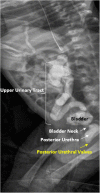Posterior urethral valves: Role of prenatal diagnosis and long-term management of bladder function; a single center point of view and review of literature
- PMID: 36683802
- PMCID: PMC9853300
- DOI: 10.3389/fped.2022.1057092
Posterior urethral valves: Role of prenatal diagnosis and long-term management of bladder function; a single center point of view and review of literature
Abstract
Posterior Urethral Valves (PUV) are the most common cause of lower urinary tract obstruction. More severe forms are detected early in pregnancy (mainly type I), while other forms are usually discovered later in childhood when investigating lower urinary tract symptoms. Bladder dysfunction is common and is associated with urinary incontinence in about 55% (0%-72%). Despite the removal of the obstruction by urethral valve ablation, pathological changes of the urinary tract can occur with progressive bladder dysfunction, which can cause deterioration of the upper urinary tract as well. For this reason, all children with PUV require long-term follow-up, always until puberty, and in many cases life-long. Therefore, management of PUV is not only limited to obstruction relief, but prevention and treatment of bladder dysfunction, based on urodynamic observations, is paramount. During time, urodynamic patterns may change from detrusor overactivity to decreased compliance/small capacity bladder, to myogenic failure (valve bladder). In the past, an aggressive surgical approach was performed in all patients, and valve resection was considered an emergency procedure. With the development of fetal surgery, vesico-amniotic shunting has been performed as well. Due to improvements of prenatal ultrasound, the presence of PUV is usually already suspected during pregnancy, and subsequent treatment should be performed in high-volume centers, with a multidisciplinary, more conservative approach. This is considered to be more effective and safer. Primary valve ablation is performed after clinical stability and is no longer considered an emergency procedure after birth. During childhood, a multidisciplinary approach (pediatric urologist, nephrologist, urotherapist) is recommended as well in all patients, to improve toilet training, using an advanced urotherapy program with medical treatments and urodynamic evaluations. The aim of this paper is to present our single center experience over 30 years.
Keywords: bladder function; bladder outlet obstruction; eUrogen; pediatric; posterior urethral valves; prenatal diagnosis; renal function; urodynamic.
© 2023 Pellegrino, Capitanucci, Forlini, Zaccara, Lena, Sollini, Castelli and Mosiello.
Conflict of interest statement
The authors declare that the research was conducted in the absence of any commercial or financial relationships that could be construed as a potential conflict of interest.
Figures




References
Publication types
LinkOut - more resources
Full Text Sources
Miscellaneous

